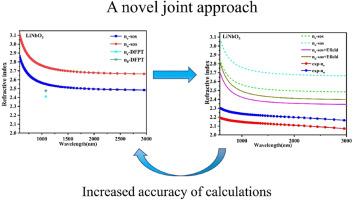结合密度泛函微扰理论的第一性原理和过态法得到精确的折射率色散曲线
IF 3.9
Q3 PHYSICS, CONDENSED MATTER
引用次数: 0
摘要
本文介绍了一种获得折射率色散曲线的新方法:密度泛函微扰理论与第一性原理态和的联合方法。针对第一性原理和过态法计算的LiNbO3、LiGaSe2和BPO4材料的折射率色散曲线和双折射率存在一定偏差的问题,引入了密度泛函微扰理论方法。但是,密度泛函摄动理论方法只能得到光频处的折射率,因此,结合第一性原理和过态方法可以得到精确的折射率色散曲线。为了进一步研究参数对折射率和双折射率的影响,引入了LiNbO3、LiGaSe2和BPO4材料的不同泛函、不同截止能、不同k点、离子贡献和固定对称性。结果表明,超态和法的对称性是影响双折射率计算精度的重要因素。本文章由计算机程序翻译,如有差异,请以英文原文为准。

A new strategy of getting accurate refractive index dispersion curves using first-principles sum-over-states method jointed by density functional perturbation theory
This paper introduces a new method for obtaining refractive index dispersion curves: the joint method of density-functional perturbation theory and first-principles sum-over-states. Since the refractive index dispersion curves and birefringence of LiNbO3, LiGaSe2 and BPO4 materials computed by the first-principles sum-over-states method have some deviations, the density-functional perturbation theory method is introduced. However, the density-functional perturbation theory method can only obtain the refractive index at the optical frequency, so the first-principles sum-over-states combined with the density-functional perturbation theory method can be used to obtain the accurate refractive index dispersion curve. To further investigate the effect of parameters on the refractive index and birefringence, the different functionals, different cutoff energies, different k-points, ionic contributions and fixed symmetry are introduced for LiNbO3, LiGaSe2 and BPO4 materials. The results show that symmetry-fixed nature of sum-over-states method is an important factor affecting the accuracy of the calculated birefringence.
求助全文
通过发布文献求助,成功后即可免费获取论文全文。
去求助
来源期刊

Computational Condensed Matter
PHYSICS, CONDENSED MATTER-
CiteScore
3.70
自引率
9.50%
发文量
134
审稿时长
39 days
 求助内容:
求助内容: 应助结果提醒方式:
应助结果提醒方式:


